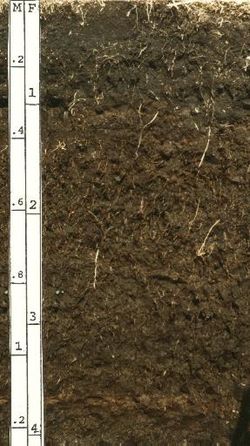Histosol
| Histosol | |
|---|---|

a Histosol profile
|
|
| Used in | WRB, USDA soil taxonomy, other |
| WRB code | HS |
| Profile | OC |
| Parent material | Organic matter |
| Climate | subarctic, other |
In both the FAO soil classification and the USDA soil taxonomy, a histosol is a soil consisting primarily of organic materials. They are defined as having 40 centimetres (16 in) or more of organic soil material in the upper 80 centimetres (31 in). Organic soil material has an organic carbon content (by weight) of 12 to 18 percent, or more, depending on the clay content of the soil. These materials include muck (sapric soil material), mucky peat (hemic soil material), or peat (fibric soil material). Aquic conditions or artificial drainage are required. Typically, histosols have very low bulk density and are poorly drained because the organic matter holds water very well. Most are acidic and many are very deficient in major plant nutrients which are washed away in the consistently moist soil.
Histosols are known by various other names in other countries, such as peat or muck. In the Australian Soil Classification, histosols are called Organosols.
Histosols form whenever organic matter forms at a more rapid rate than it is destroyed. This occurs because of restricted drainage precluding aerobic decomposition, and the remains of plants and animals remain within the soil. Thus, histosols are very important ecologically because they, and gelisols, store large quantities of organic carbon. If accumulation continues for a long enough period, coal forms.
...
Wikipedia
